
(a)
Interpretation: An image representing various reactions is given. Various questions based on the given image are to be answered.
Concept introduction: According to the collision theory, for a reaction to take place the molecules must collide in proper orientation and must have minimum energy so that the effective collisions may occur.
To determine: The two images that describe the elementary steps which when combined depicts the destruction of Ozone by Chlorine.
(a)
Answer to Problem 13.12VP
Solution
The two images that describe the elementary steps which when combined depicts the destruction of Ozone by Chlorine are given by figure A and H.
Explanation of Solution
Explanation
The equation for the destruction of Ozone by Chlorine is given as,
The equation (1) is represented by the figure A as shown,

As three red balls correspond to
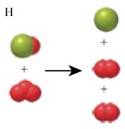
As three red balls correspond to
Conclusion
The two images that describe the elementary steps which when combined depicts the destruction of Ozone by Chlorine are given by figure A and H.
(b)
Interpretation: An image representing various reactions is given. Various questions based on the given image are to be answered.
Concept introduction: According to the collision theory, for a reaction to take place the molecules must collide in proper orientation and must have minimum energy so that the effective collisions may occur.
To determine: The image that represents the overall reaction for the Chlorine catalyzed destruction of Ozone.
(b)
Answer to Problem 13.12VP
Solution
The image that represents the overall reaction for the Chlorine catalyzed destruction of Ozone is given by figure E.
Explanation of Solution
Explanation
The equation for the destruction of Ozone by Chlorine is given as,
The overall reaction is given as,
This situation is represented by figure E as shown below,
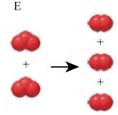
As three red balls combined in reactants correspond to
Conclusion
The image that represents the overall reaction for the Chlorine catalyzed destruction of Ozone is given by figure E.
(c)
Interpretation: An image representing various reactions is given. Various questions based on the given image are to be answered.
Concept introduction: According to the collision theory, for a reaction to take place the molecules must collide in proper orientation and must have minimum energy so that the effective collisions may occur.
To determine: The two images that describe the elementary steps which when combined describes the overall reaction in which
(c)
Answer to Problem 13.12VP
Solution
The two images that describe the elementary steps which when combined describe the overall reaction in which
Explanation of Solution
Explanation
The reaction involving
The equation (3) is represented by figure D as shown below,
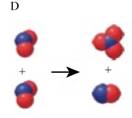
Here, a pair of combined red and blue balls corresponds to

Here, three combined red balls along with one blue ball corresponds to
Conclusion
The two images that describe the elementary steps which when combined describe the overall reaction in which
(d)
Interpretation: An image representing various reactions is given. Various questions based on the given image are to be answered.
Concept introduction: According to the collision theory, for a reaction to take place the molecules must collide in proper orientation and must have minimum energy so that the effective collisions may occur.
To determine: The chemical equation for the reaction described in question (c).
(d)
Answer to Problem 13.12VP
Solution
The chemical equation for the reaction described in question (c) is,
Explanation of Solution
Explanation
The reaction involving
The chemical equation for the overall reaction is given by adding equation (3) and (4) as,
Conclusion
The chemical equation for the reaction described in question (c) is,
(e)
Interpretation: An image representing various reactions is given. Various questions based on the given image are to be answered.
Concept introduction: According to the collision theory, for a reaction to take place the molecules must collide in proper orientation and must have minimum energy so that the effective collisions may occur.
To determine: The image that shows photodecomposition of Chlorofluorocarbons.
(e)
Answer to Problem 13.12VP
Solution
The image that shows photodecomposition of Chlorofluorocarbons is given by figure G.
Explanation of Solution
Explanation
The decomposition of Chlorofluorocarbons is given as,
This equation is represented by figure G as shown below.

As four combined green and one black ball at left hand side corresponds to
Conclusion
The image that shows photodecomposition of Chlorofluorocarbons is given by figure G.
(f)
Interpretation: An image representing various reactions is given. Various questions based on the given image are to be answered.
Concept introduction: According to the collision theory, for a reaction to take place the molecules must collide in proper orientation and must have minimum energy so that the effective collisions may occur.
To determine: The decreasing order for the collision between Ozone and chlorine atoms.
(f)
Answer to Problem 13.12VP
Solution
The decreasing order for the collision between Ozone and chlorine atoms is
Explanation of Solution
Explanation
The absence of Ozone is represented by the blue cloud. The cloud is bigger in figure I, it means Ozone is most depleted in figure I and it corresponds to the maximum number of collisions between Ozone and Chlorine atoms as shown below,
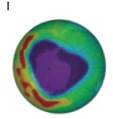
Then figure F shows the less depletion of Ozone in comparison to figure I as shown below,

The least depletion of Ozone is shown in figure C as shown below,
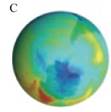
Therefore, the decreasing number of collisions is given by
Conclusion
The decreasing order for the collision between Ozone and chlorine atoms is
Want to see more full solutions like this?
Chapter 13 Solutions
Chemistry: The Science in Context (Fifth Edition)
- Please help me Please use https://app.molview.com/ to draw this. I tried, but I couldn't figure out how to do it.arrow_forwardPropose a synthesis of 1-butanamine from the following: (a) a chloroalkane of three carbons (b) a chloroalkane of four carbonsarrow_forwardSelect the stronger base from each pair of compounds. (a) H₂CNH₂ or EtzN (b) CI or NH2 NH2 (c) .Q or EtzN (d) or (e) N or (f) H or Harrow_forward
- 4. Provide a clear arrow-pushing mechanism for each of the following reactions. Do not skip proton transfers, do not combine steps, and make sure your arrows are clear enough to be interpreted without ambiguity. a. 2. 1. LDA 3. H3O+ HOarrow_forwardb. H3C CH3 H3O+ ✓ H OHarrow_forward2. Provide reagents/conditions to accomplish the following syntheses. More than one step is required in some cases. a. CH3arrow_forward
- Identify and provide an explanation that distinguishes a qualitative and quantitative chemical analysis. Provide examples.arrow_forwardIdentify and provide an explanation of the operational principles behind a Atomic Absorption Spectrometer (AAS). List the steps involved.arrow_forwardInstructions: Complete the questions in the space provided. Show all your work 1. You are trying to determine the rate law expression for a reaction that you are completing at 25°C. You measure the initial reaction rate and the starting concentrations of the reactions for 4 trials. BrO³¯ (aq) + 5Br¯ (aq) + 6H* (aq) → 3Br₂ (l) + 3H2O (l) Initial rate Trial [BrO3] [H*] [Br] (mol/L) (mol/L) | (mol/L) (mol/L.s) 1 0.10 0.10 0.10 8.0 2 0.20 0.10 0.10 16 3 0.10 0.20 0.10 16 4 0.10 0.10 0.20 32 a. Based on the above data what is the rate law expression? b. Solve for the value of k (make sure to include proper units) 2. The proposed reaction mechanism is as follows: i. ii. BrО¸¯ (aq) + H+ (aq) → HBrO3 (aq) HBrO³ (aq) + H* (aq) → H₂BrO3* (aq) iii. H₂BrO³* (aq) + Br¯ (aq) → Br₂O₂ (aq) + H2O (l) [Fast] [Medium] [Slow] iv. Br₂O₂ (aq) + 4H*(aq) + 4Br(aq) → 3Br₂ (l) + H2O (l) [Fast] Evaluate the validity of this proposed reaction. Justify your answer.arrow_forward
 ChemistryChemistryISBN:9781305957404Author:Steven S. Zumdahl, Susan A. Zumdahl, Donald J. DeCostePublisher:Cengage Learning
ChemistryChemistryISBN:9781305957404Author:Steven S. Zumdahl, Susan A. Zumdahl, Donald J. DeCostePublisher:Cengage Learning ChemistryChemistryISBN:9781259911156Author:Raymond Chang Dr., Jason Overby ProfessorPublisher:McGraw-Hill Education
ChemistryChemistryISBN:9781259911156Author:Raymond Chang Dr., Jason Overby ProfessorPublisher:McGraw-Hill Education Principles of Instrumental AnalysisChemistryISBN:9781305577213Author:Douglas A. Skoog, F. James Holler, Stanley R. CrouchPublisher:Cengage Learning
Principles of Instrumental AnalysisChemistryISBN:9781305577213Author:Douglas A. Skoog, F. James Holler, Stanley R. CrouchPublisher:Cengage Learning Organic ChemistryChemistryISBN:9780078021558Author:Janice Gorzynski Smith Dr.Publisher:McGraw-Hill Education
Organic ChemistryChemistryISBN:9780078021558Author:Janice Gorzynski Smith Dr.Publisher:McGraw-Hill Education Chemistry: Principles and ReactionsChemistryISBN:9781305079373Author:William L. Masterton, Cecile N. HurleyPublisher:Cengage Learning
Chemistry: Principles and ReactionsChemistryISBN:9781305079373Author:William L. Masterton, Cecile N. HurleyPublisher:Cengage Learning Elementary Principles of Chemical Processes, Bind...ChemistryISBN:9781118431221Author:Richard M. Felder, Ronald W. Rousseau, Lisa G. BullardPublisher:WILEY
Elementary Principles of Chemical Processes, Bind...ChemistryISBN:9781118431221Author:Richard M. Felder, Ronald W. Rousseau, Lisa G. BullardPublisher:WILEY





